|
Ship's
Log: Updated December 23, 2007
Christmas Greetings!
Our last passage and arrival on Isla Providencia inspired Tracy to write this Christmas poem.
Don’t Follow the “Yellow Brick Road”
T’was the week before Christmas and all through the boat;
The crew was exhausted, happy to be afloat.
The anchor's dug deep into mud and sand;
We're waiting for Christmas on this beautiful island.
The sun shines down between afternoon squalls;
Then we watch rain come down in thick blowing walls.
We worked hard to be in this beautiful land;
Dodging shrimpers at night and crab pots in the sand.
Three weeks have passed since we left Mexico;
The road much longer than we would think or know.
We left in a blow, the waves standing up;
Bashing and rocking made our stomachs say “yuck”.
We took a long break on an uninhabited isle;
Waiting for better weather, we stayed for a while.
Honduran fisherman were doing the same;
We became friends and got to know them by name.
They traded fresh snapper with us every day;
They wouldn’t accept money, saying it was not their way.
Six lonely paratroopers looked after the place;
Tracy fit right in, a big smile on his face.
After a week we headed back to fresh wind;
Tropical storm Olga was dissipating then.
Dodging the pirates on the Honduran coast;
We slipped into Nicaraguan waters, calm for the most.
Up onto the Gorda Bank we did glide;
No clue of how wild was the upcoming ride.
The current pushed hard on the following day;
Determined to make us go out of our way.
We stuck to our course through the growing swell;
Gellie began hoping that soon land she would smell.
Finally the light from Providencia we spied;
"Land Ho” is what the happy crew cried.
Captain Morgan's descendants inhabit this mountain in the sea;
And they welcome us, sincere and warm-hearted as can be.
How long we will stay here we yet don’t know;
But later to Panama we will certainly go.
We hope you enjoy the following update;
As usual we are sorry that it was posted so late.
In case we don’t talk until the New Year rolls in;
Merry Christmas to you all, our very special friends!
Time for Moving On
We visited the port captain and immigration officials to acquire our "zarpe" that allowed us to depart Isla Mujeres, Mexico on Friday, November 30, though with much preparation still to be completed. As mentioned in our last update, we also added a crew member for the Mexico to Panama leg, Stefan Schnur, a German national who has lived in Port Townsend, Washington for the past several years. He turned out to be a big help in getting Landfall provisioned and ready for the next leg.
Not only did we have preparations still to complete, but the weather forecast was not favorable for a departure on Friday. For Saturday morning, December 1, the forecast was 6-8 foot waves with 25 knot winds, diminishing on Sunday to 4-6 foot waves with 15 knot winds. We decided we could live with Sunday's forecast, and planned our actual departure for then. Though we were now technically illegal in Isla Mujeres after checking out, the port captain assured us that staying on for a couple of weekend days would be fine.
Leaving Isla Mujeres
After topping off the fuel tanks and jerry jugs on Sunday morning, we left the fuel dock on the leeward side of the island at 12:20 PM. Little to our pleasure, we found that once we rounded Anvil Rock and got out beyond the reef on the windward side of Isla Mujeres, the waves were still 6-8 feet and if the wind had moderated at all, we could not tell. Hmmm...maybe we should have waited another day? Ah, well, we're in it now!

We set out in what could be described as a confused and troubled sea, so raised the tiny staysail and tied a double reef in the main for motor-sailing, to try to give us some stability. Even with the sails helping to reduce the rolling and pitching, to accomplish anything other than bruises we had to hang on with both hands as we moved around. Shortly after dark Sharon was power-barfing over the side, her sea legs not quite yet under her after so many months at the dock. We also began standing watch, each of us on in rotation every three hours, with six hours off to rest.
Fortunately over the next couple of days the wind and waves continued to moderate. By Monday morning we were able to cut the engine and sail in lively conditions. By Tuesday morning, the seas had become very calm and we were sailing nicely along our course.

We even had dolphins for company, playing in our bow wake!
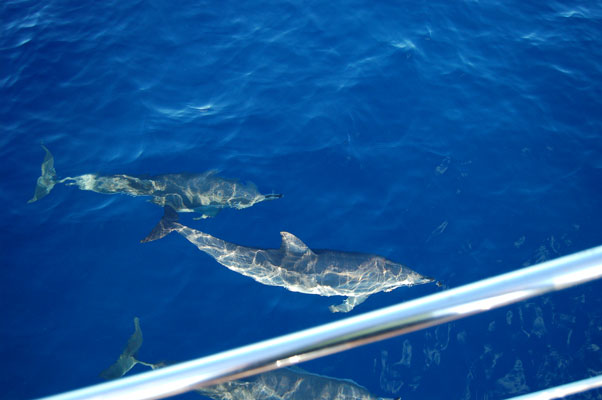

Well as the saying goes, be careful what you wish for, because by one o'clock that afternoon, the winds had slowed so much that we had to crank the engine and motor-sail to make any reasonable progress. By two o'clock Wednesday morning the wind had died completely and the sea was glass calm. Too much or too little seemed to be the theme, with a nice period of sailing in between to let us rest and relax without the engine running.
Where are We Going?
We were headed for two small islands off the coast of Honduras called Islas Santanilla, also called the Swan Islands, also called Islas del Cisne, to drop the hook and get a good night’s sleep before heading on. Because the wind had died and we motor very slowly, especially against the strong current we encountered, it looked like we were not going to make it in before nightfall Wednesday night, so we had to creep along at about 2 knots throughout the night, to ensure we did not make landfall until the following morning. We really did not want to get too close to the islands in the dark!
Our timing was perfect: "There they are, right behind the sunrise!"
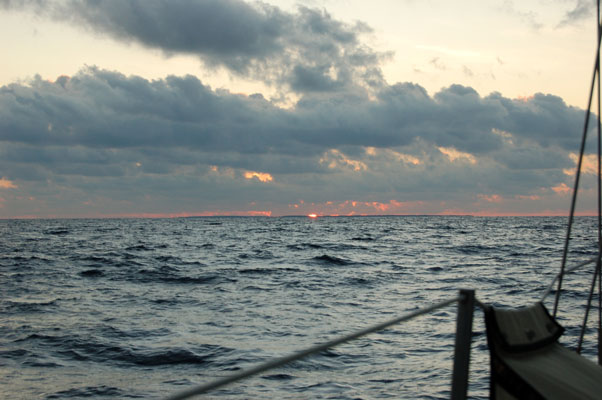
On his early morning watch before arriving at the island Tracy took a long look at the small scale chart. Realizing how familiar the chart seemed, the light went off in his tired brain: Islas Santanilla was the Caribbean sister to Isla Tigre, located on the Pacific coast of Honduras. Tracy was familiar with Isla Tigre as one of the American military outposts used in the 1980’s to monitor shipping traffic between Nicaragua and El Salvador during those tumultuous days when he was stationed in Panama. Islas Santanilla, its Caribbean sister outpost, was used to monitor traffic between Cuba and El Salvador. When he revealed this epiphany to Sharon and the crew, they promptly agreed it was time for Tracy to get some sleep. Meanwhile, the morning just kept getting more beautiful as the sun rose over the islands.
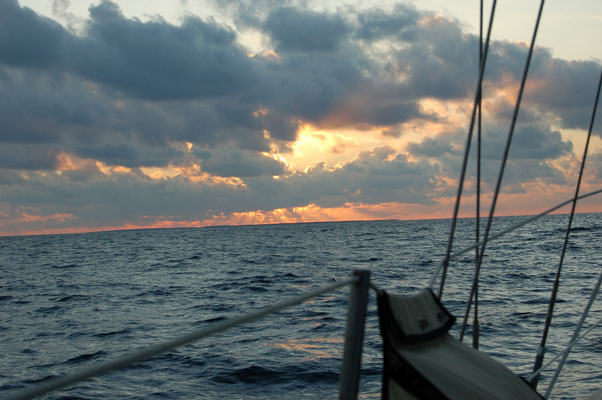
At 8:50 AM on Thursday, December 6th, after four days at sea, we dropped the hook to the sandy bottom in front of rocky cliffs on the southwestern side of this beautiful uninhabited island, and got ready for a well deserved nap.

Just as we were completing our anchoring chores we heard someone yelling from the cliffs about 200 yards away. We looked out and saw three armed Honduran soldiers calling out to us in Spanish. After trying unsuccessfully for about 10 minutes to communicate who we were, why we were there and how long we were staying, Tracy and Stefan jumped into the water and swam over to the rocky cliffs.
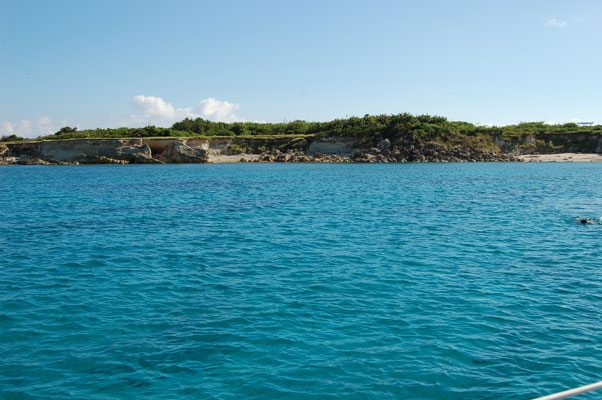
Checking in to Honduran Territory
On the long swim over Tracy was thinking that there were three possibilities of what was likely to occur once they reached the cliffs. First, the soldiers could want to clear us into Honduras and charge us an immigration fee. Second, they could say that we were there illegally and immediately arrest us. Or third, they could just tell us that we could not stay there and that we would have to leave immediately.
On arriving at the shoreline, there was a fourth possibility that Tracy had not even considered: that they were a squad of paratroopers manning the outpost and performing essentially the same function the Americans had been performing twenty years earlier. As soon as Tracy scrambled up on the rocks and saw the Honduran jump wings on the First Sergeant’s uniform, he sounded off with a loud and thunderous “HOOAH!, PARACADEISTA!” bringing an immediate smile of respect and the corresponding “HOOAH, HOOAH!” from the proud non-commissioned officer in charge (NCOIC) of the detachment and the other non-commissioned officer (NCO) there with him. They told us that they wanted to collect our information for their duty log, and also told us that there was a much better anchorage just around the corner of the island, a few hundred yards away.
Tracy and Stefan swam back to the boat and told Sharon the good news/bad news: we were checked into the island, but we had to haul anchor and move to another anchorage. Not the news she wanted to hear! Fortunately, the new anchorage was a bit more protected from the wind, and worth the effort.
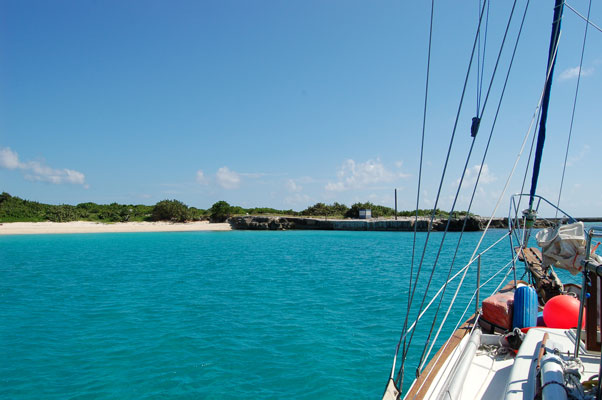
When we got around to the new anchorage, the First Sergeant and the other NCO were sitting on the old wharf waiting for us. Tracy swam in to meet them and asked if we were in the correct spot. He said yes, and said that Tracy should invite the rest of the crew (including Gellie) ashore. We asked if we could take a walk around the island and he told us to feel free to go anywhere we liked, but first he would like to show us the camp.
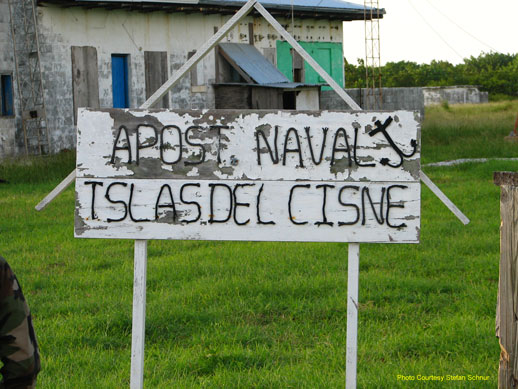
Once we got there, he offered us cool water and told us the history of the island, and said that their primary function was to watch for drug runners as opposed to the gun runners of the American days. He also said that a million-and-a-half dollar appropriation for improvements to the base had been misappropriated somewhere along the line, and so the improvements would have to wait awhile longer.
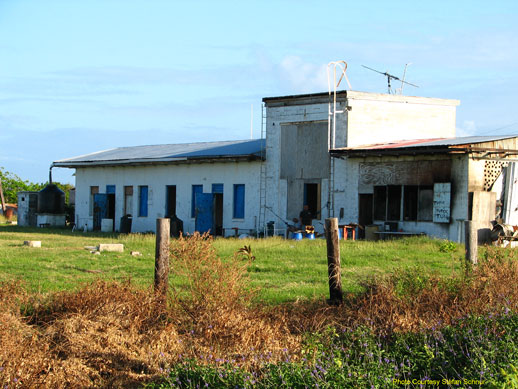
There are a total of six soldiers on the island who stay for eighty day rotations. They live very simply, with water that is brought in on a supply boat, very basic provisions, and no alcohol. The nearest land is over 100 miles away.
When we asked again about the best places to see on the island, he told us that the afternoon patrol was leaving at 1:30 and that we would be welcome to walk the patrol with them. Needless to say, Tracy jumped at the chance to walk a working patrol on the island with the soldiers.
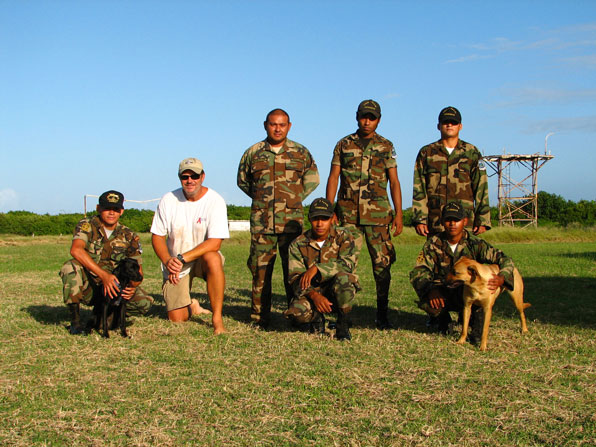
The patrol was actually more like a guided tour of the island. The soldiers were very excited to show us around the island, pointing out the wildlife, plants and trails around to the windward side. Along the way, we saw iguanas, feral house cats left by the Americans and huge boobies in hatching season awkwardly guarding their nests. The cats are an invasive species and very destructive to both the iguana and booby populations. The soldiers, showing a surprising attention to the natural order of the environment, make a concerted effort to control the feral cats in order to protect the boobies and iguanas.
Once we made it to the other side of the island one of the soldiers cut some fresh green coconuts and offered us our fill of the sweet water and jelly inside. Our Gellie could care less about the cocos and just wanted to run up and down the beach after being on the boat for five days!
Shopping for Fish
While we were on the beach there, a fishing boat that visits the island every two weeks showed up just offshore and one of the fishermen rowed into the beach to greet the soldiers and drink a green coco. We had had no luck fishing on the way down, so asked the fisherman if we could buy some from him to supplement our stores. He said that he would be pulling around to the other side of the island shortly and we could buy some then. To our surprise, when we got back to Landfall there was not one but two fishing boats. We had agreed among ourselves that we would spend no more than $20 for the fish, and we would just see how much we could get for that.
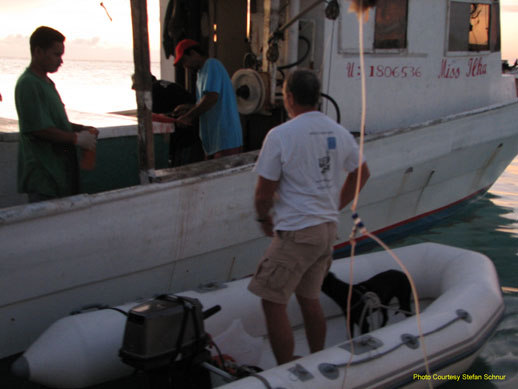
It turns out that the fishermen were from the Bay Islands of Honduras, specifically Guanaja, and to our surprise spoke English fluently, though with a heavy Creole accent. When we asked how much they wanted for the fish, they told us that they could get $1.75 per pound when they got home. So, we agreed to buy ten pounds of fresh snapper, caught hours before. We expected them to weigh the fish but instead they told us to just take what we wanted from the huge pile that they were busily cleaning. Tracy had picked out four good sized fish that he thought were about three pounds each when the fishing boat captain said to “give them another big one”. At the end of the transaction, it appeared that we had about fifteen pounds of fish for $20! Our first thought was “What a deal!” and our second thought was “What are we going to do with all of this fish?!?”
It turns out that our new crew member, Stefan, has three great loves. Being German, the first is good micro-brew beer. Having lived near Seattle for a long time, the second is good coffee. The third and most important to us at that precise moment is his love of preparing and cooking fish. Not only is it a passion for him, it is a true natural talent!
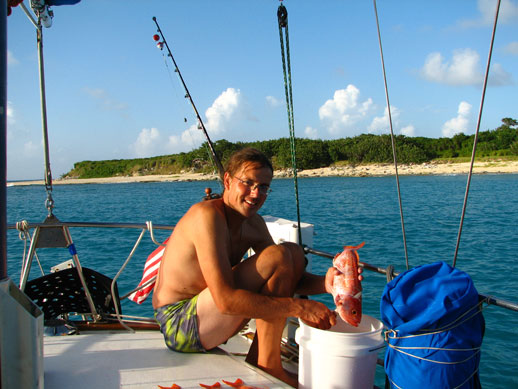
For the next several nights he cooked up different meals that, to our delight, would rival the finest restaurants in New York or Chicago! We were in heaven, anchored off a beautiful island in the Caribbean, enjoying the sunshine, and feasting on gourmet meals every night.
One morning, inspired, Stefan baked what he called "biscuits" and what Tracy dubbed "cat head muffins," putting in everything: freshly shelled pecans he'd brought aboard, gleaned from under his uncle's tree in Comanche, Texas as he was getting ready to crew on the boat before ours, dried cranberries from the Cancun Costco, raisins, and whatever else he could scrounge from Landfall's galley stores. Fantastic!
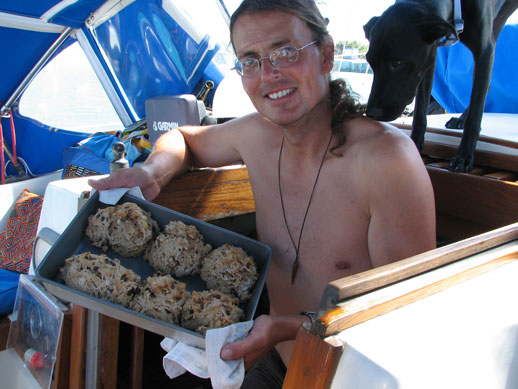
For side dishes, we usually cooked black beans and rice, along with salads made with the remaining cabbage and cucumbers from Isla Mujeres, dressed in a vinegar and sesame oil dressing. Jasmine once helped to sort the black beans before soaking.
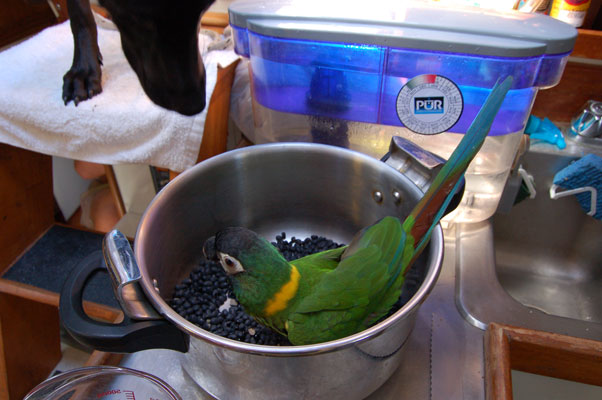
Trying the Local Cuisine
The next day we learned that the second fishing boat was having problems with dirty fuel and would be there with us for the next couple of days while they waited for new filters coming on another boat. Meanwhile, the fishing boat crew made themselves busy catching and cooking iguana for their meals. When Stefan and Tracy talked to the captain that next day he offered them some of the leftover iguana tail they had roasted over an open fire on the beach for lunch. To make a long story short, it was delicious! The Captain insisted that they take a plate back to Landfall to share the treat with Sharon, which they gladly obliged. With a little hesitation, Sharon gave it a try and loved it also. But she swears it was because of the spices! Here's to new culinary experiences!
Later that day one of the crew members rowed up to Landfall asking if we had any playing cards on board. We supplied him with a spare deck and sent him on his way. A few hours later, he rowed back with two huge Yelloweye snapper. Tracy offered to pay him for the fish, but he said “that is not our way, we just want you to have them”.

You can see where this cycle is going: we now had a daily supply of fish, which kept Stefan very happy cooking away; in turn, Tracy and Sharon were eating gourmet meals daily, and being very friendly with the fishing boat crew. We were in no hurry to leave this anchorage!
In all, we ended up spending a week on the island waiting out the rough weather with our new friends. Each day we would work on the boat a bit, then Tracy and Gellie would go up to the camp for afternoon physical training with the troops. They would alternate between playing American football and soccer. When they got back to the boat, both would be too exhausted to do anything other than eat and sleep. Meanwhile, crew member Stefan would spend his free time walking the island taking photographs of the beauty that surrounded us, and dreaming up new and delicious ways to prepare snapper.
Getting Thirsty
The only thing that could limit our stay at this point was our dwindling supply of fresh water. We realized on the first day out of Isla Mujeres that we were losing the water in the top half of our tank to a leak. This could turn into a real problem, so we had been trying everything we knew to conserve the precious gallons that remained in the tank. We resorted to washing dishes in salt water with only a light fresh water rinse at the end, and jumping into the water to wash ourselves. Economy alone would not get us through; we finally had to break down and “make” water with the machine we had purchased and installed back in Pensacola seven months ago.
This was a heck of a time to find out whether it was going to work! But the time had definitely come. Lo and behold, Sharon read the operator’s manual and with crossed fingers flipped the switch. Wha-hoo! It worked like a champ and within minutes was spitting out sweet fresh water that tasted delicious. We were finally self-sufficient, and could stay as long as we liked!
A Walk on the Beach
On Sunday, December 9th, after listening to Stefan’s stories about his walks around the island, it was Sharon, Tracy and Gellie’s turn to go exploring. The island is about four kilometers long and maybe one and a half kilometers wide. So, that would make a walk around the island about eleven kilometers, or a little more than seven miles. A nice stroll on the beach, take some pictures. Let's go!
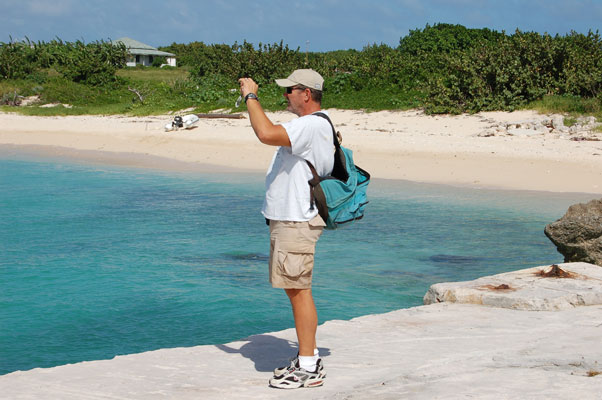
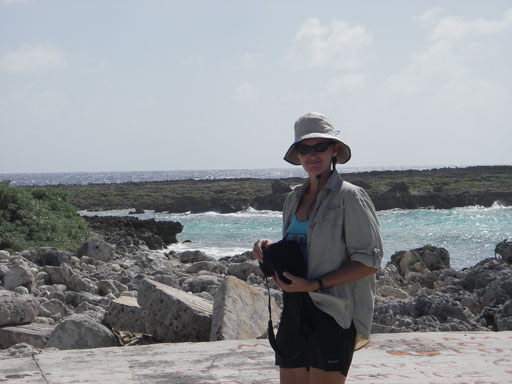
Did we mention the cliffs on the island? As it turns out, about one-third of the island has a lovely sandy beach. Roughly the other two-thirds is covered with jagged coral, sharp volcanic rock and sheer cliffs. Any attempt to go inland from the beach in all but a couple of places is blocked by dense mangrove trees and undergrowth. Also, all of the nesting boobies, our primary interest, are concentrated on the most rugged portions of this route.
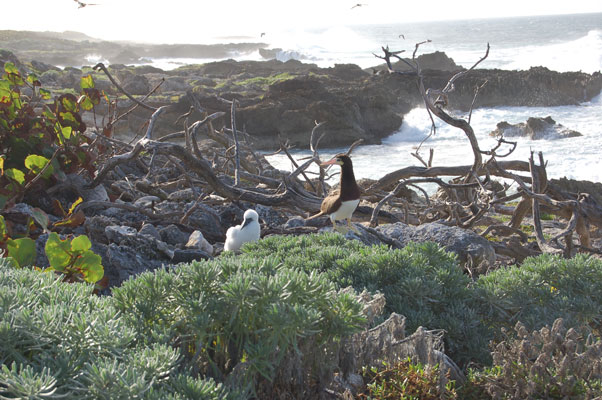
We beached the dingy boat about noon and returned to it around 4:45 that afternoon, making for an almost five hour walk-climb-scramble around the island. The volcanic rock was so sharp in many places and the climbs so difficult that Tracy had to throw Gellie over his shoulder and carry her.
The last two hundred yards before the final short stretch of beach were the toughest, as we were on the edge of the cliffs with toe and finger holds forty feet above the volcanic rocks below. The wind was howling like a banshee and the waves thundered onto the shore. Gellie was perched on Tracy’s shoulder in a fashion that would make Jasmine proud, and Sharon was being reminded that wandering around precarious heights was not her favorite pastime.
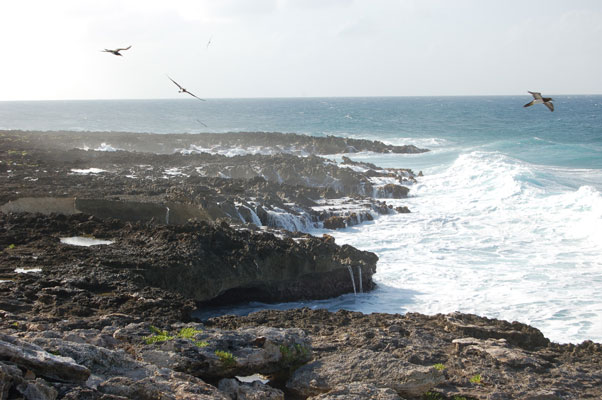
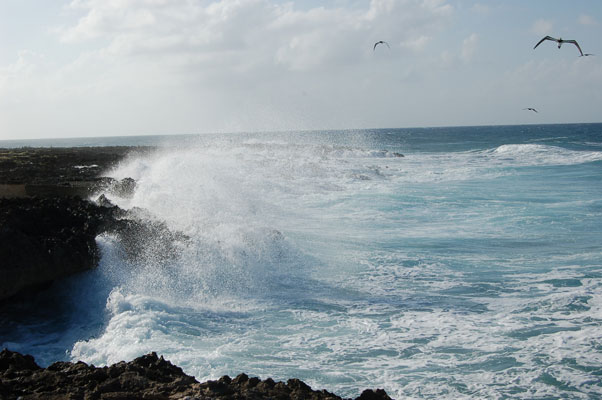
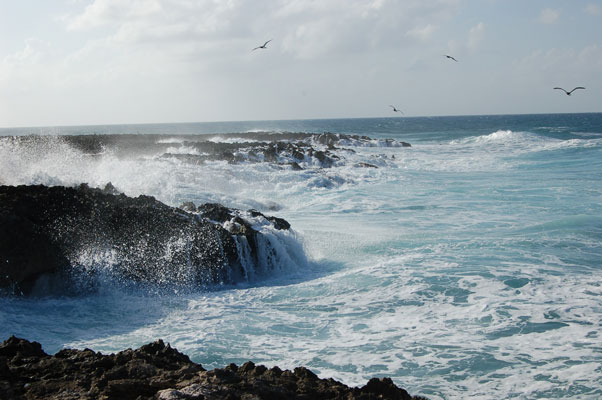
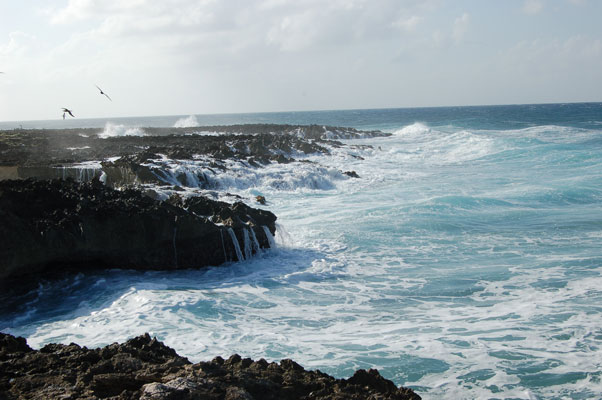
All in all, it made for a very athletic day of relaxation!
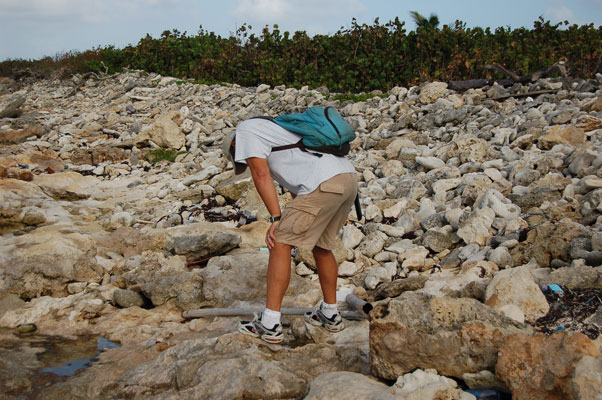
Home of the Booby
As we had hoped, when we were on the northern side of the island there were Brown Booby nests everywhere, hundreds of them. You had to look before each step to keep from stepping on a nest or eggs,
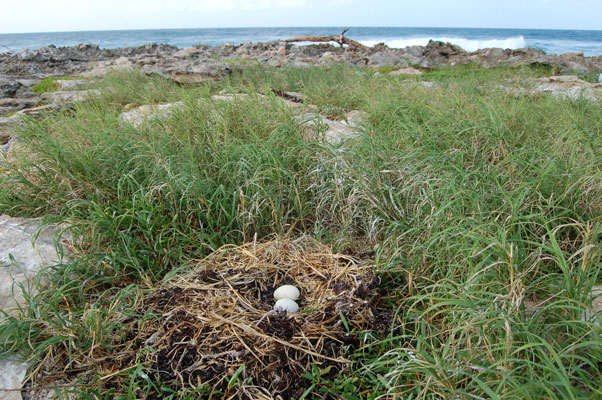
or the new hatchlings that ranged from tiny featherless forms to fluffy white babies as large as their parents. Hungry babies,
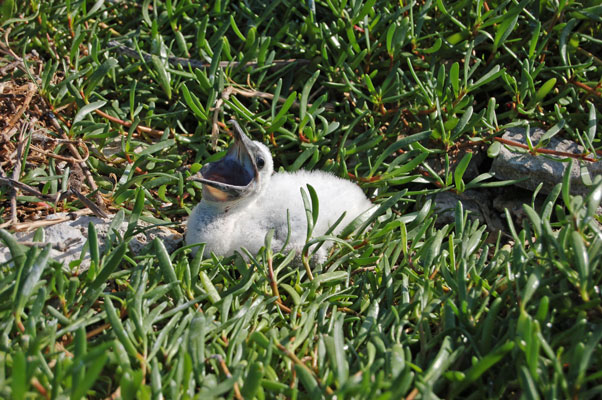
hiding babies,
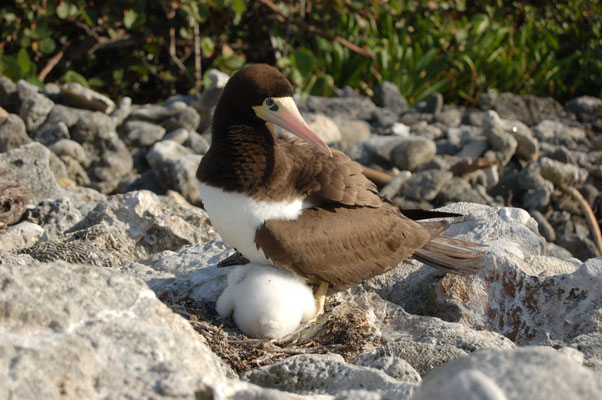
shy babies,
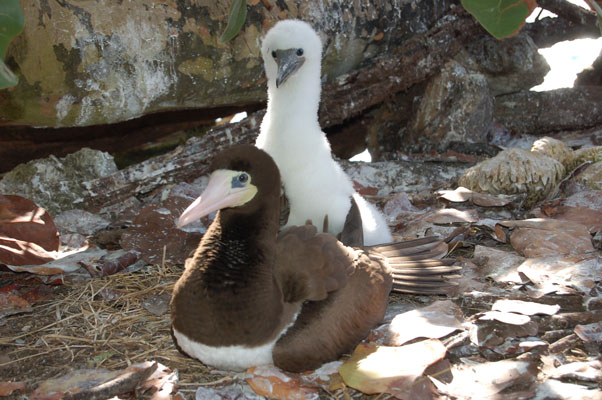
huge baby boobies!

It was like walking into your television screen in the middle of a Discovery Channel special. Without a doubt, being right in the middle of a natural phenomenon that only a handful of humans have ever witnessed beyond a television screen is a reminder of why we are out here to begin with. Awesome!
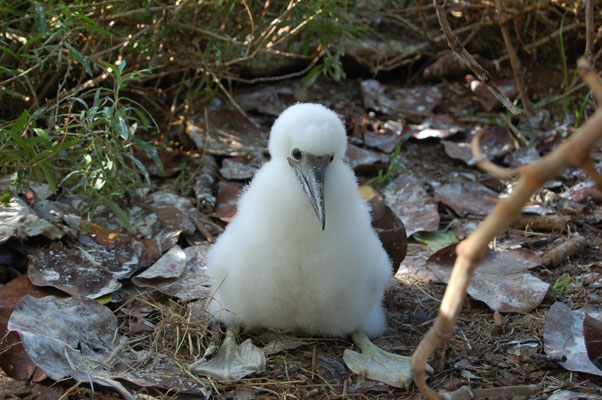
And boobies weren't the only bird life on the island; this Pelican came to visit us, too!
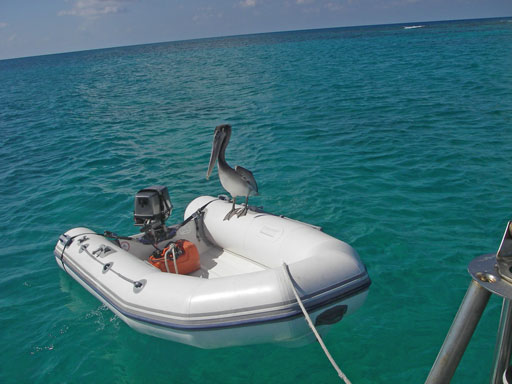
Time to Move On?
Back on the boat, the wind was starting to blow harder and the waves were picking up in the anchorage. We had begun to discuss how long we wanted to stay, and where we would go next. We all agreed that it would be prudent at this point to check the weather forecast before we committed ourselves to any decision.

Finally, it was time to try out another new piece of technology, accessing the Internet using our new satellite phone and a laptop computer. The phone vendor had set the software up on Tracy’s computer and everything seemed to work correctly, with the computer calling through to the connection site. Due to the significant expense of actually connecting to the web site, they made sure the modem rang through to the site, but never allowed it to connect the call fully, which would have initiated the charges. So when Tracy set up the computer on Isla Santanilla and he dialed in to connect, the system did exactly what it had done in practice: it called the site, and when the site answered to connect, the phone promptly hung up! Over, and over, and over again!!
OK, this is obviously not going to work as easily as the watermaker did!
What's With This Weather?
Meanwhile, the waves and wind are growing in ferocity and the fishermen who had their fuel problems solved decided that they didn’t want to go out fishing in these conditions. Rule of thumb: if a professional Honduran fishing crew says it is too rough to be out on the water, believe them!
Now it is time for Plan B. We are thinking that we really need to know what is going on with the weather. Although we could not connect to the Internet with the satellite phone, we could still make phone calls and send text messages with it. So, we sent a text message out to our friends the Kens, Kenny Geoghagan in Atlanta, and Ken Carter in Gulf Shores. We were hoping that one or both of them would be near their computer, able to check the forecast for our location, and respond back to us. It turns out that both received our text, but only Ken Carter’s phone provider would allow him to reply to us, and he generously gave us numerous updates over the course of the afternoon and evening, and the next day.
Even though Kenny Geoghagan wasn’t able to respond, we owe both him and Ken Carter a great deal of thanks for all of the things they do in support of our adventures. It does take a great deal of assistance to be “self sufficient,” and while we are out here having all the fun, we say thanks many times a day when something has been made possible or even easier for us due to the efforts of friends and family back home.
The reports coming back from Ken were not very encouraging. It was rough out and getting rougher. Further, Tropical Storm Olga was headed our way, but would probably stay to the north of us. Our choice was now between the lesser of two evils, stay put in the anchorage and take what we get, or head south and try to get below it. We decided to wait a couple of days for the worst of the current system to blow through, and then try to head south before the effects of Olga were upon us.
Our next leg would be toward two islands, both Columbian possessions about 200 miles north of our ultimate goal of Bocas del Toro, Panama. Isla Providencia, at 280 miles away the closer of the two, is less developed and is inhabited almost entirely by the descendants of Captain Morgan. Isla de San Andrés, another full day's sail further south, is more developed and has more options for re-provisioning. We decided to head for them both, and see how we felt after a few days at sea.
Heading On from Islas Santanilla
On Wednesday, December 12th, Stefan and Tracy walked up to the camp to say goodbye to the first sergeant and his men while Sharon continued preparing Landfall to head out to sea again. Gellie reluctantly said goodbye to her new friends and was hooked into her tether for the next leg.

At 8:45 AM we hauled the anchor and set out into the 15-20 knot winds and 6-8 foot seas for a blustery sail with a double reefed mainsail and staysail. Did we leave too soon again?? Well, at least we all have our sea legs now! Even if the waves tower over our heads!
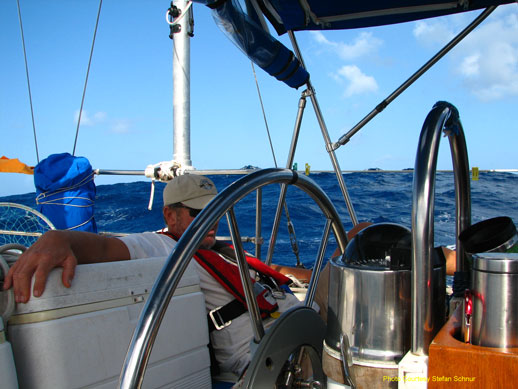
We began our three hour watch rotation and by the next morning we were sailing along nicely with the wind down to 10 knots and the second reef shaken from the mainsail. The seas had dropped to 4-6 feet, making the ride a little more comfortable. Later that afternoon, the wind continued to diminish and we knew that the seas would follow suit so we raised the mizzen sail.
By the 14th, the wind and seas had diminished substantially and we were sailing with the full rig with light winds and calm seas as we eased up onto the Nicaraguan Rise and the shallow waters of the Gorda Bank off the huge shoulder of land that makes up the Honduran/Nicaraguan border. Normally we would try to stay away from shallow banks because when the wind and waves do kick up they are amplified by deep water hitting shallow water, and the squalls increase due to the change in water temperature between the two. On this passage the Gorda Bank was unavoidable, and with the weather this benign we decided to take a shortcut route across the bank to shorten the passage.
Crossing the Gorda Bank
We would be up on the bank for two days. The first day was smooth and uneventful, with the exception of a crab boat coming up to check us out after they had laid their traps. The water was too smooth; we were alternating between sailing slowly and motoring as we watched the floats from the crab pots go past. Other than the routine afternoon squalls, it was a chance to take turns with naps and fishing along the way.
On the second day it was more of the same until about noon, when we managed to snag one of the crab pot lines on the keel. Suddenly, on the calm water, the boat took a hard heading change and the line got dragged into the prop. It was Tracy’s turn to nap down below, and Sharon, though off watch, acted quickly by first putting the boat in neutral, then once she realized what was going on, spun the prop briefly in reverse to try to clear the line.
A line around the prop and shaft can do very serious damage very quickly, as we both witnessed watching a racing boat in Pensacola wrap his prop with a dock line. If you don’t act quickly and correctly, you can rip the shaft right out of the transmission, and even through the fiberglass hull! Fortunately, quick thinking and correct action saved us from serious damage and did in fact spin the line free. After a few nervous moments to collect ourselves and check the boat for damage, we were on our way again.
Visitors on the Gorda Bank
One thing that surprised us on the Gorda Bank the first morning was the appearance of a U.S. Coast Guard Cutter. We didn’t get close enough to see the name of the ship on the hull but were filled with pride to see our tax dollars at work. A half hour after the sighting, their helicopter came by to pay us a visit, hovering low over our bow and then our stern to identify us and to make sure we were OK. This gave us comfort because if we were going to see pirates in the Caribbean, this is probably where we would see them.
On the second morning on the bank, another Coast Guard helicopter visited, checked us out, dipped its rotors and waved at us, and disappeared over the horizon. It felt good to be an American.
Nightmare on the Gorda Bank
Our last night on the Gorda Bank was all fun and games to make up for the ease of the past two days. Right after we crossed the border into waters off the Nicaraguan coast we started seeing shrimp boats working their nets. The wind was shifting and the current was gaining strength as we approached the southwest edge of the bank. There was only going to be a sliver of a moon, and by sunset the sky was darkened by very frequent squalls.
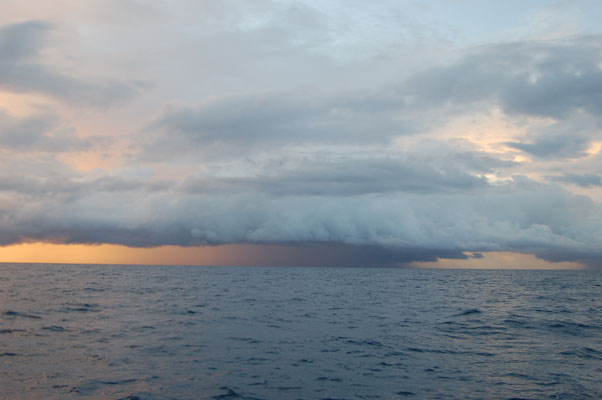
This was our fourth night out, and fatigue was taking a toll on all of us. As the sky darkened, trawler lights winked on the horizon as far as we could see, and we knew it would be a long night.
On Sharon’s midnight to three o'clock watch a light loomed into view off the starboard bow. After watching it through binoculars she looked at the radar to try to determine which way it was headed and how far off it was. Soon after, another light appeared right off its stern: a blinking yellow light, indicating a tow. The trawler seemed to be heading away from us, but with the tow behind, it seemed prudent to alter course away from it, just in case.
Very soon after another light appeared, but this one was off the port bow, but it seemed to be trailing behind the towed light. Could it be the tail end of a very long tow? It certainly seemed close, too! Alter course away from it, if so!
Altering course seemed to veer us away from the dangerous tows, and the mother ship was still heading away from us, so Sharon relaxed. Not for long, though, as a sudden squall appeared out of the dark night and violently slammed the boat with sideways rain and fierce gale-strength gusts, backing the staysail. At the same time, the autopilot alarm screamed that we were off course. As Sharon disengaged the autopilot and grabbed the wheel, she found it was hard over to port, and it refused to budge. Had we been caught by the tow after all??
Landfall spun around of its own accord, and the helm was stuck. The rain was pouring down in buckets and the wind screamed. Tracy, off watch and sleeping in the aft cabin, heard the commotion and came topsides. "What's happening?" "I don't know! There was a trawler and tow lights, then this squall hit, the autopilot couldn't keep course, and the helm won't respond! I think maybe we're caught in a fishing net!"
"Are you in neutral? Have you tried backing off?" "Yes, no, the helm won't respond. I don't know what else to do!"
"Let's try backing off again." We did; it worked! The helm was responding. Then the squall subsided. We took deep breaths and looked at the lights all around us, seeming to encircle us and getting closer. Are we caught in a huge net, about to be swept up in it along with all the fish, turtles, and other bycatch? To Sharon, sleep-deprived, scared, cold and wet at 3:30 in the dark morning, it certainly seemed like it!
We inched ahead, moving away from the closest lights as Tracy went below to study the radar to try to determine which lights were ships, which lights were just tow lights atop the nets, and which tow lights belonged to which ships. He called out course corrections to Sharon, hand-steering at the helm.
For an hour and more we zigged and zagged our way through a murderous maze of trawlers and nets. Finally, achingly slowly, the sky began to lighten with early morning twilight, and the trawler lights began to resolve into daylight and solid shapes. Man, we were glad that night was over!
Back in Deep Water
Around dawn on Saturday morning we crossed off the shallow Gorda Bank into hundreds of feet of water, clear of the fishing traffic. However, the comfort of deep water was offset by a very strong current, stiffening winds, growing seas, and frequent squalls. We were only a hundred miles away from our next stop, but it looked like it was going to be a long hundred miles.
Traveling at about three knots we would cover the first seventy-five miles on Saturday, leaving us to close in on landfall at Low Cay, an anchorage just north of Isla Providencia, about ten o'clock Sunday morning. Low Cay offered easy refuge from the swells behind a long reef that extends eight miles south to Isla Providencia. We needed a night's rest before negotiating an unknown channel into the anchorage at Catalina Harbor.
Most of Saturday we were able to sail at a comfortable pace. Close to dark, Stefan even caught our first fish, finally! It turned out to be a delicious King Mackerel, which we enthusiastically ate as sushi and grilled steaks for dinner.
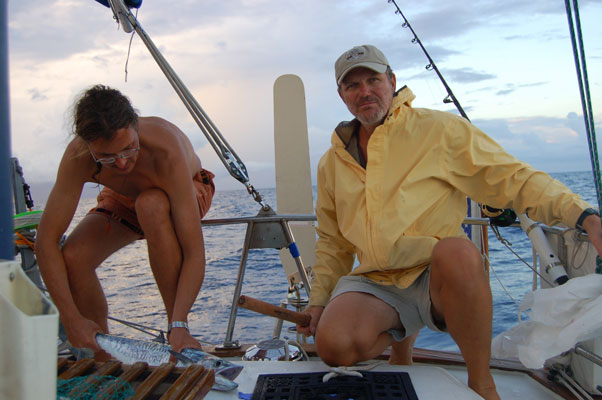
By the time Saturday night rolled around we started going through violent squalls followed by periods of brief calm, repeating the cycle time and time again throughout the night. It was exhausting, and we would all be happy to see this leg of the passage come to an end! We were looking forward to the moment when we could drop the hook into the same sandy bottom used by the pirates and privateers centuries before, in an historic Caribbean hideaway.
After the toughest two nights of our travels to date we made landfall and dropped the hook off of Low Cay, a wide-open anchorage leeward of the reef just eight miles north of Isla Providencia, at 11 AM. Though the wind was still howling, the waves, which had been about six feet outside the reef, dropped off to mere wavelets behind the reef. We could rest and sleep without hanging onto something!
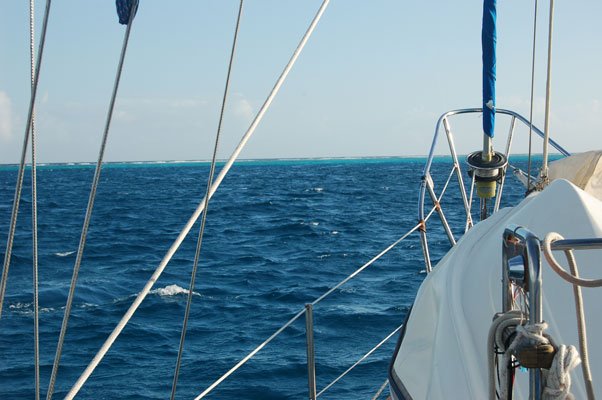
Not wanting to disturb the local officials on a Sunday and desperately in need of some sleep, we decided we would stay at Low Cay for the night and then pull the hook and motor into Catalina Harbor the next morning. Until then we would have an adult beverage or two and then get some well deserved rest. And so we did: we slept like babies from 2:45 in the afternoon until 7 AM the next morning!
After the difficult time we had had the two previous nights, we asked ourselves if it was all worth the effort. Then we looked out over the reef to see the breaking waves, and back over to the mountains of Isla Providencia only eight miles away, and simultaneously agreed, “ABSOLUTELY!”
Stay tuned for the update about our adventures on this lovely island paradise!
|
![]()